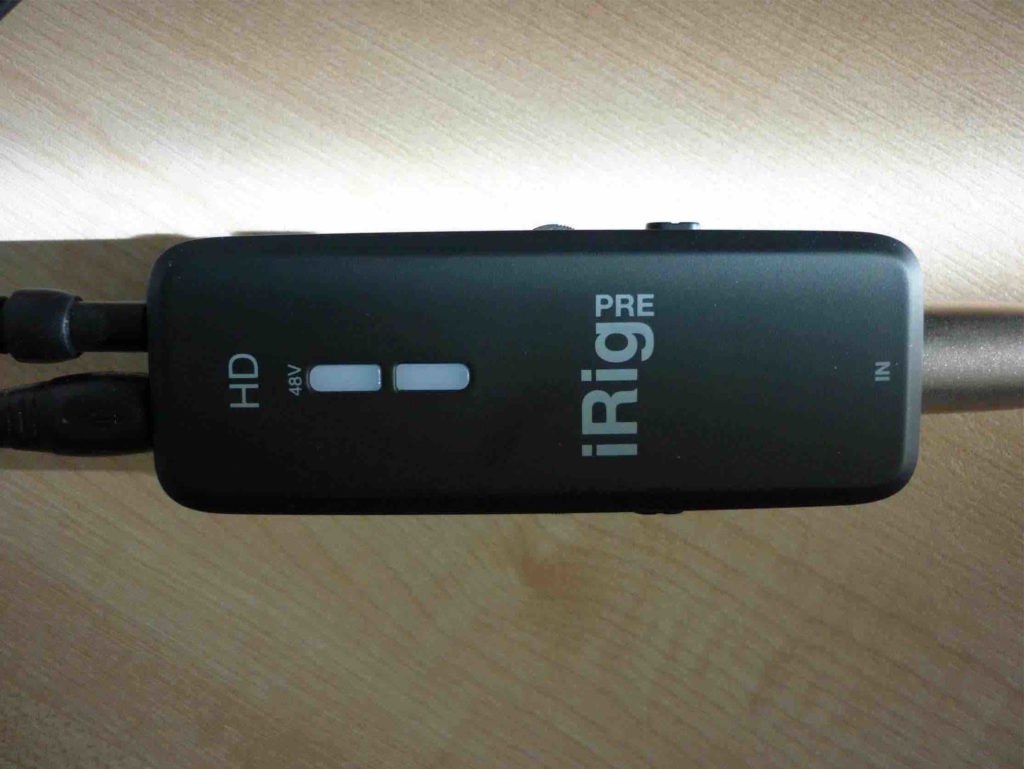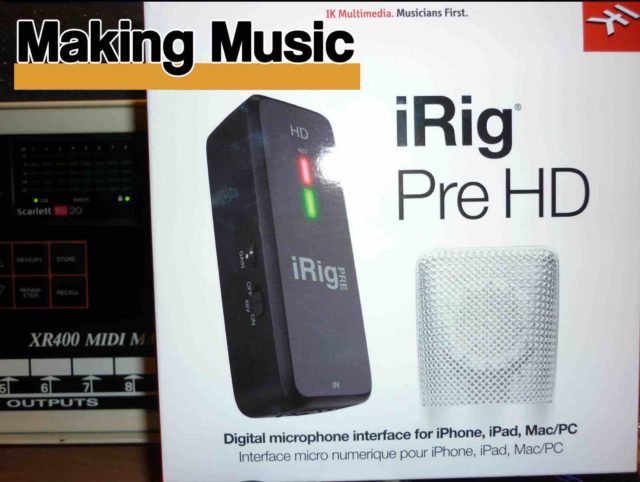Last Updated on February 17, 2018 by Gareth Patch
iRig Pre HD Microphone Interface
Manufacturer: IK Multimedia
Website: IK Multimedia
Price: €99.99 (excl. VAT)
Mobile music making is becoming easier and most of us, whether we know it or not, have a very well specified recording platform within our smart phones or tablets. The weak link in the chain until recently has been the connectivity to get high quality audio into our pocket studios.
Among others, IK Multimedia has developed a range of affordable interfaces to suit an individual’s needs. Originally beginning with a guitar-centred solution (in partnership with their AmpliTube software), they have now turned their attention to high-quality recording for microphones. The iRig Pre HD is one of over a dozen small-form interfaces from IKM to suit different needs, ranging from the aforementioned guitars and microphones, to MIDI connections and combinations of all three.
iRig Pre HD – What is it?
The iRig Pre HD is small enough to fit in the palm of your hand and is coated in a slightly rubberized, black coating that prevents it slipping around when placed on a desktop. It sports a single XLR input, a 3.5mm stereo headphone output, which also doubles as a line out and a USB mini-B type socket for connection to a device. While the mini-B is not the most secure of connection types, it seems appropriate to use it on a unit of this size.
On one side there is a rotary gain control and a switch for phantom power and on the other side a rotary headphone level and a switch for direct monitoring.
Finally, on the top of the unit, there are two LEDs: one which confirms that the unit is connected to a device and also doubles as a basic input level meter (green/orange for good signal, red for clipping) and another to show that phantom power is engaged. All in all, this is a well thought out design with all the major requirements available on the hardware, rather than being reliant on software control.
In the box, you get the interface, a USB mini-B to full size USB A, a USB mini-B to Lightning, two AA batteries and a Velcro strap so you can attach the unit to a microphone stand should you wish.
The unit itself is class-compliant and is certified as a ‘Made for’ device so is guaranteed to work straight out of the box with Apple iOS devices with Lightning connections. It is also compatible with Android devices as well as Windows 7 and up and Apple computers running OSX 10.6 and later.


On the bench
I like to start a review period by seeing how intuitive a product is, so I jumped right in without reading any instructions and plugged it straight into my phone. Now, I’m not a great user of iOS devices to make music so I was at a disadvantage to begin with but, within a minute or two, I had a microphone level going into GarageBand without any trouble at all. What surprised me was that to get this healthy level I only had to turn the gain control to 2 with an SM58 attached. The unit has bags of power in the preamp and so it shouldn’t really be any trouble getting the majority of microphones to give you a suitable recording.
Testing with a large diaphragm condenser also yielded good results. The on-board phantom power didn’t struggle with the mic and I didn’t need to add any gain at all to get a good signal. It would have been nice to use an onboard ‘comfort’ reverb while monitoring via the software, but the latency was noticeable and so the Direct Monitoring switch was used. Although there is no independent volume control for it, balancing the input level to the backing track was easy in the recording software.
Direct and to the point
I then turned my attention to getting a guitar into the DAW (I guess even on a phone GarageBand is a DAW, right?) but as the iRig Pre is only fitted with an XLR I had to use a DI box for this particular test. Should you want an interface with XLR/Jack combi-sockets then these are available in some of IK’s other products. My guitar signal dutifully appeared in an amp sim with loads of level, in fact with so much that I had to engage a pad on the DI box to make it manageable, which I have never had to do with a guitar via a DI box before. This time though, the latency was less noticeable and so playing through the amp sim was viable for recording.
Small size, big sound.
But how did it sound? Well, it sounded clean and uncoloured, at least while I was listening to the headphone output. As with the input, the output level had plenty of power to drive my closed-back headphones and, auditioning some pre-recorded material showed it to be a detailed and distortion-free experience. This isn’t going to give you the quality of some of the high performance interfaces that are on the market, but it’s certainly no slouch. Considering it’s connected to a phone, I was pleasantly surprised.
As for the actual recorded sounds, I decided that some critical listening was best done via my main Adam monitors and Focusrite interface in the studio. The recordings proved themselves clean and clear and it would appear that the Class-A Preamp in the iRig Pre HD does exactly what it’s supposed to, with no colouration in the sound recorded. Considering this has the capacity to run at 24-bit/96kHz, you begin to wonder if there are any downsides, even with the miniaturisation of current technology.


Return of the Mac
Getting the interface to work with my main Mac, was again, a breeze and it showed up immediately for use. Being bus-powered meant that phantom power was available even without batteries installed. In fact, the only time the batteries are required (as far as I can tell) is when you want to use a condenser mic or DI box when connected to an iOS device. If you’re just using a dynamic mic or listening to music via the Pre HD then it will run from power from the Lightning connection, which I did for a couple of hours during my review period, without troubling my rather ageing iPhone 5’s battery more than I expected.
Practice makes perfect
For a final test, I wanted to know how useful it would be to have the iRig Pre/iPhone combo as a live recorder in a band rehearsal situation. I’ve never really been satisfied with using a phone’s internal mic to record rehearsals as they tend to get distorted and battered with the signal level, so I took the iRig Pre HD and an omni-directional LDC to see what I could get.
As with the DI box, the input level was too hot to begin with, so I had to engage a pad on the microphone. This isn’t necessarily a bad thing, but if the mic had no pad, then this combination would be unusable. However, after a couple of attempts at placing the microphone in the optimum position (we rehearse all facing inwards to the centre of the room) the results were better than I had got from the phone mic alone, with a rather loud (and tuneful) noise being captured for checking performance issues or recording new ideas. I wouldn’t necessarily say I would buy an iRig Pre HD specifically for this use, but if you’ve already got one, it adds an extra task that it can fulfil.


IK Multimedia’s iRig Pre HD – Summary
All in all, this little device could be just what you are looking for. It’s compact enough that it will fit in a pocket, powerful enough (perhaps too powerful) to be used with most if not all microphones and headphones, while being an affordable solution to getting quality audio into an iOS or Android device while on the move.
Pros
Size and sound quality
Powerful headphone amplifier
Plug and play with Apple products, but also compatible with Android and Windows
Bags of power in the mic preamp
Cons
Mono XLR input only, although there are other devices available in the range to fulfil most requirements
USB mini-B connection not the most secure
No volume control for direct monitoring signal
Perhaps too much preamp gain for some situations

















